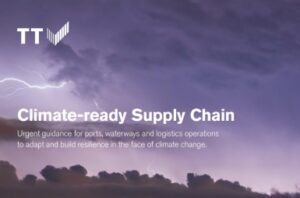
A recent joint study by TT Club and engineering consultancy Royal HaskoningDHV reveals that nearly 90% of the world’s 3,700 major ports are exposed to climate hazards, placing billions of dollars of infrastructure and global trade at risk.
The report, titled Climate-Ready Supply Chain: Urgent Guidance for Ports, Waterways and Logistics Operations, provides a comprehensive framework for assessing climate risks and adopting resilience strategies across the maritime sector.
The study warns that rising sea levels, extreme weather, and changing regulations are increasingly threatening ports, terminals, and logistics operations, vital parts of the global supply chain. Past disasters, such as the Gulf Coast port shutdown during Hurricane Katrina and Japan’s 2011 tsunami that caused $12 billion in maritime losses, show how damaging unprepared infrastructure can be.
Neil Dalus, Risk Assessment Manager at TT Club, said climate change is no longer a future threat but a current operational challenge. He warned that inaction could lead to higher repair costs, longer disruptions, and revenue losses, while early adaptation could save costs, ensure stability, and improve industry reputation.
Marika Calfas, TT Club Board Member and CEO of NSW Ports, said ports face the greatest impacts from climate change. She highlighted that building resilience into port infrastructure and operations is critical. The report offers guidance on understanding risks, planning responses, and integrating resilience into business strategies
The report emphasises that climate risks are inevitable and require immediate attention. Delays in action could increase damages and costs, while proactive planning could protect ports and the wider supply chain from future disruptions. The guidance also outlines emerging opportunities for ports to improve operations. These include using real-time climate data, IoT-based monitoring systems, and AI-powered predictive analytics to improve asset management, reduce downtime, and enhance emergency readiness. The report cites examples like the Port of Long Beach’s Coastal Resiliency Plan and the Port of Brisbane’s upgraded weather monitoring as successful climate adaptation efforts.
Amy Savage, Technical Director of Climate Risk and Adaptation at Haskoning, said climate adaptation should be seen as a strategic investment rather than an expense. She said combining engineering expertise with advanced digital technology can create strong, future-ready port infrastructure that boosts efficiency.
The joint TT Club–Haskoning report offers a practical and timely framework for the maritime industry to address climate challenges. It calls for integrating climate resilience into core strategies to secure the long-term stability and competitiveness of ports and global logistics networks.
Download the report: TT Club - Climate-ready supply chain whitepaper